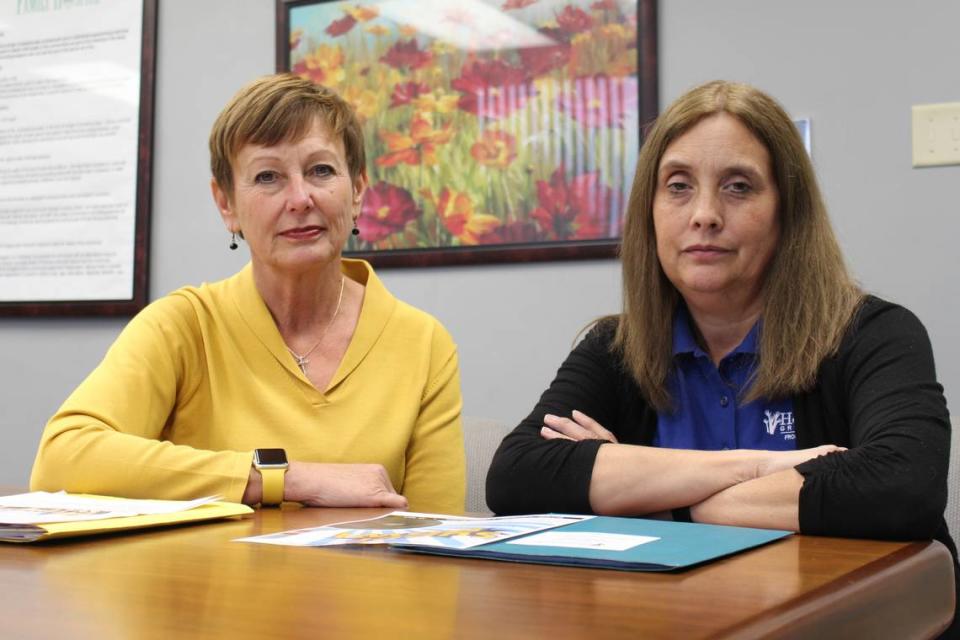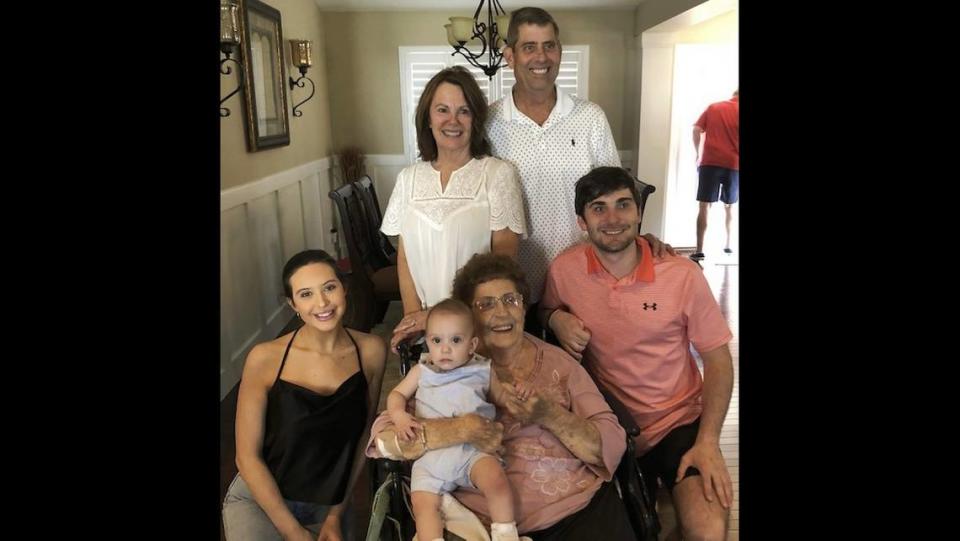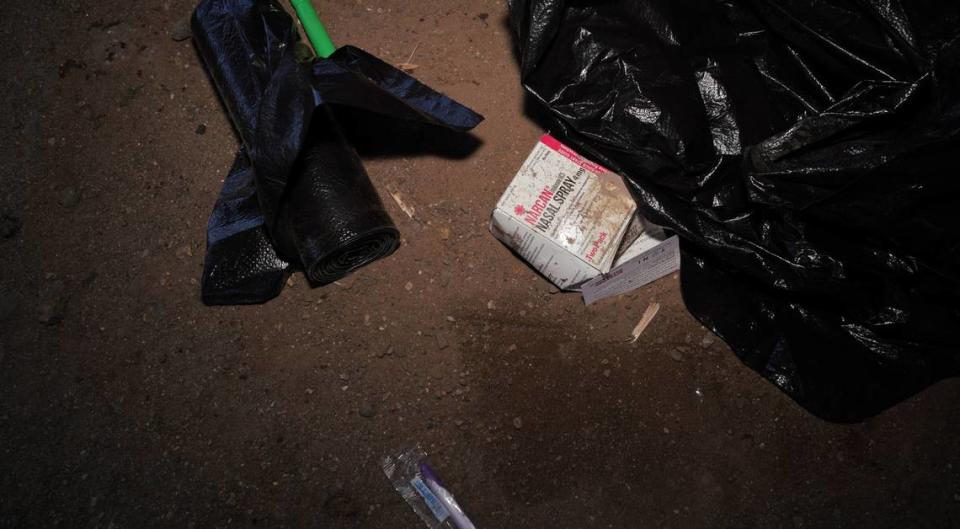In troubling development, drug dealers are selling straight fentanyl in the metro-east
Fentanyl continues to be a formidable enemy of health officials, law enforcement, friends and families in the metro-east.
In some ways, the problem has gotten worse, according to Diana Cuddeback, director of Heartlinks Grief Center in Belleville. She contributed to the book “Heartbroken: Grief and Hope Inside the Opioid Crisis,” which focuses on Madison, St. Clair and surrounding counties.
In 2019, when Heartlinks board member Ellen Krohne self-published the book, she and Cuddeback noted that some drug-related deaths had resulted from people unknowingly using heroin laced with fentanyl.
“Now I’m seeing (fentanyl) in other drugs, and people are also using it straight — on purpose,” Cuddeback said recently.
Cuddeback leads an Addiction Loss Support Group through Heartlinks, a program of Family Hospice. She formed it in 2016 due to increases in the number of people who had lost loved ones due to drug overdose.
Cuddeback’s anecdotally based information matches national data showing that heroin use is down, said Matthew Ellis, associate professor of psychiatry at Washington University School of Medicine in St. Louis, who also contributed to “Heartbroken.”
Ellis describes “four waves” of the opioid epidemic: Prescription pain medicine, heroin laced with fentanyl, cocaine and methamphetamine laced with fentanyl and now straight fentanyl sold in pill form.
“The drug cartels have shifted away from heroin,” he said. “Why spend months and months and months cultivating opium poppy fields when you can just create fentanyl in a lab in a few days?”

More potent than morphine
The U.S. Drug Enforcement Administration describes fentanyl as a synthetic opioid that’s 100 times more potent than morphine as a pain reliever and anesthetic. It’s legally manufactured and distributed in the United States.
However, licit fentanyl pharmaceutical products sometimes get diverted via theft, fraudulent prescriptions and illicit distribution by patients, physicians and pharmacists.
“Most recent cases of fentanyl-related overdose are linked to illegally made fentanyl, which is distributed through illegal drug markets for its heroin-like effect,” the U.S. Centers for Disease Control and Prevention website states.
“It is often added to other drugs because of its extreme potency, which makes drugs cheaper, more powerful, more addictive, and more dangerous.”
Many national, state and local databases don’t differentiate between fentanyl and other opioids when reporting overdose deaths since they’re often mixed, according to Ellis. But in 2021, Madison County Coroner Steve Nonn divided 82 deaths into the following categories :
Fentanyl — 19
Fentanyl plus other drugs, including heroin — 14
Fentanyl and methamphetamine — 33
Fentanyl and methamphetamine plus other drugs — 4
Fentanyl and cocaine plus other drugs — 5
Prescription opiates — 2
Other opioids plus other drugs — 4
Methadone and hydrocodone — 1

National and regional figures
When “Heartbroken” was published in 2019, the most recent data showed the Madison County opioid overdose death rate had soared from 8.3 deaths per 100,000 population in 2006 to 32.1 in 2017, when 82 people died of opioid overdoses. That compared to 21 people in St. Clair County.
Updated figures on opioid overdose death rates (deaths per 100,000 population) show a worsening situation for most of the following:
United States — 14.9 in 2017; 24.7 in 2021
Illinois — 17.2 in 2017; 23.7 in 2021
Missouri — 16.5 in 2017; 27.1 in 2021
Madison County — 32.1 in 2017; 29.3 in 2021
St. Clair County — 8.8 in 2017; 26.7 in 2021
City of St. Louis — 60.3 in 2017; 90.01 in 2021
St. Louis County — 27.6 in 2017; 36.4 in 2021
The Madison County rate decreased slightly, leading it to be ranked 10th in the state. It was first in 2015.
A total of 77 people died of opioid overdoses in Madison County in 2021, according to the Illinois Department of Public Health. That number is slightly lower than Nonn’s list of 82 deaths cited earlier, probably due to differences in reporting parameters, Ellis said.
The number of people who died from opioid overdoses in St. Clair County went from 21 in 2017 to 69 in 2021, causing its rate to more than triple.
“It’s hard to say what’s driving that,” Ellis said. “It’s possible that Madison County has had a better response in terms of EMS using naloxone to revive people. .... It also may be there’s just a greater influx (of drugs) in St. Clair County.”
Naloxone is a medication designed to rapidly reverse opioid overdose that can be administered via nasal spray or injection. Some people call it “Narcan” because that was the first brand name.

Case led to homicide charge
In recent years, one of the most notable fentanyl-related cases in southeastern Illinois involved Clayton Augustine, 27, of Waterloo, an engaged father of an infant son. He died from an overdose in 2021.
His mother, Debbie Augustine, described him as addicted but working hard at recovery. She partly blamed his death on his drug dealer, Derek Dillion, now 36, a family friend who formerly lived in Columbia.
Dillon pleaded guilty last year to drug-induced homicide, a Class X felony, in Monroe County Circuit Court. He received a six-year prison sentence, which Debbie Augustine thought was too light.
“I don’t think that’s setting a good precedent,” she said at the time. “This is the first case like this in Monroe County. If it happens again, what are (drug dealers who kill people) going to get? Six years?”
TV station ABC7 Chicago reported last year that more collar counties, including DeKalb, DuPage, Kane and particularly McHenry, were filing drug-induced homicide charges against street dealers and other suppliers considered responsible for overdose deaths.
Chicago police detectives had started training on how to build cases through digital evidence and autopsy reports.
The TV station talked to retired gang crimes officer Terry Almanza, who had pushed for such efforts after losing her teenage daughter to a drug overdose in 2015. She now is a national activist and founder of the clearinghouse website DrugInducedHomicide.org.
“We need to send a message to these drug dealers that, ‘No more. They are going to be held accountable. If you are out there peddling this poison, you’re going to jail,’” Almanza said.

Money coming for treatment
One positive development, according to local experts, is that Illinois counties have started receiving money from settlements that corporations agreed to after being sued for helping to cause a national opioid epidemic.
In 2021, a coalition of state attorneys general settled with drug distributors McKesson, Cardinal Health and AmerisourceBergen for $21 billion over 18 years and manufacturer Janssen Pharmaceuticals and its parent company, Johnson & Johnson, for $5 billion over nine years.
Last year, some states settled with pharmacy chains CVS, Walgreens and Walmart and two more manufacturers, Allergan and Teva.
“There is money coming into counties and communities and touching people who are struggling with opioid addiction,” said Jane Nesbit, executive director of the St. Clair County Mental Health Board.
So far, that board has received more than $536,000 in settlement funds through Illinois Attorney General Kwame Raoul’s office. The Madison County Mental Health Board has received about $840,000.
The boards are distributing the money to agencies and organizations that provide drug treatment and recovery services.
In St. Clair County, that includes Chestnut Health Systems, Treatment Alternatives for Safe Communities (TASC) and the Comprehensive Behavior Health Center. Madison County is giving grants to Chestnut, Amare, Alton Memorial Hospital and the Madison County Sheriff’s Department.
“We are investing our funds in evidence-based practices and recovery-support specialists,” said Deborah Humphrey, executive director of the Madison County Mental Health Board. “They have shown that they work.”
Krohne, the “Heartbroken” author, hopes officials will also work to expand availability of naloxone.
“People should have it in their homes, particularly if they’re taking legally prescribed opioids,” she said. “A child could get into them. Schools should have Narcan — really anyplace that people gather. It’s like a defibrillator. It can bring people back.”

